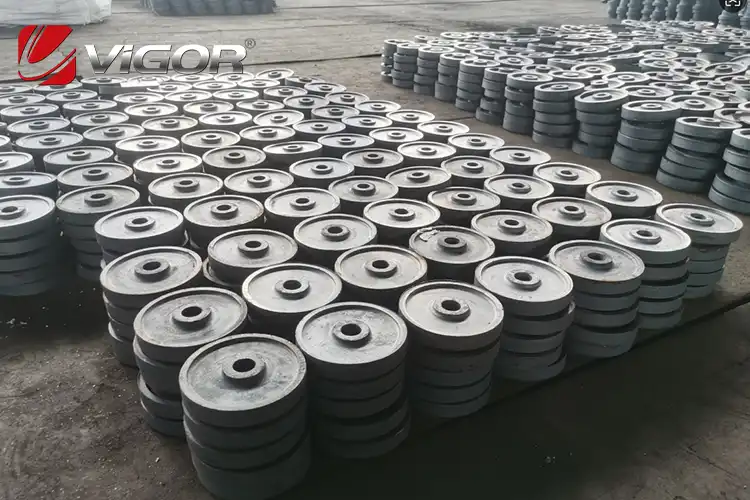
Knowledge
Vigor Die-forged Gear Plates Production and Quality Control
In the production process of gear disk blanks, quality control is the key to ensuring the accuracy of subsequent processing and the performance of the product. The following are the main quality control points in the production of blanks:
I. Raw Material Quality Control
1. Chemical Composition Testing
- Ensure that the chemical composition of raw materials (such as alloy steel) complies with standards (such as carbon, chromium, and manganese content).
- Use spectrometers or chemical analysis methods for testing to prevent excessive impurity elements.
2. Inspection of Surface and Internal Defects of Materials
- Check whether there are cracks, folds, pores and other defects on the surface of the billet.
- Detect internal inclusions, shrinkage cavities and other defects through ultrasonic flaw detection or magnetic particle flaw detection.
3. Control of Billet Size and Weight
- Precisely control the size and weight of the billet during blanking to avoid insufficient forging allowance or material waste in subsequent processes.
II. Heating Process Control
1. Heating Temperature and Uniformity
- Ensure that the billet is heated to the forging temperature range (e.g., typically 1100-1250°C for alloy steel), avoiding overburning or insufficient temperature.
- Use an infrared thermometer to monitor the furnace temperature in real time to ensure uniform heating of the billet.
2. Oxidation and Decarburization Control
- Use protective atmosphere furnaces (such as nitrogen) to reduce surface oxidation and decarburization.
- Control heating time to avoid coarse grain formation due to prolonged high-temperature exposure.
III. Forging Process Control
1. Die Condition Inspection
- Inspect the die surface for wear and cracks to ensure the dimensional accuracy of the cavity.
- Regularly clean the die surface of residues and apply lubricants (such as graphite-based lubricants).
2. Forging Parameter Control
- Deformation: Control the forging ratio (e.g., above 3:1) to refine the grain structure and enhance material density.
- Impact Force and Speed: Avoid incomplete filling due to insufficient impact force or cracking due to excessive force.
- Final Forging Temperature: Ensure the final forging temperature is above the material's recrystallization temperature (e.g., approximately 800°C for alloy steel) to prevent cold working hardening.
3. Forming Quality Inspection
- The surface of the blank has no defects such as folds, cracks, or misalignment.
- Inspected through quick visual checks or real-time monitoring by an automated vision system.
IV. Cooling and Heat Treatment Control
1. Selection of Cooling Methods
- Choose air cooling, forced air cooling or slow cooling based on material properties (for instance, high-carbon alloy steel requires slow cooling to prevent cracking).
- Avoid excessive cooling speed to prevent residual stress or deformation.
2. Stress relief annealing
- Anneal the forged blanks to eliminate internal stresses and improve machinability.
- Control the annealing temperature and time (e.g., for alloy steel, 600-700°C, holding for 2-4 hours).
V. Rough Machining Post-treatment and Inspection
1. Surface Cleaning
- Remove the oxide scale and burrs on the surface of the rough casting (such as by sandblasting or acid washing).
- Inspect whether the cleaned surface is smooth and free of residual defects.
2. Dimension and Geometric Accuracy Inspection
- Use calipers and coordinate measuring machines to inspect the key dimensions of the blank (such as outer diameter, thickness, and preformed contour of the gear blank).
- Check the positional tolerances of the blank, such as coaxiality and flatness.
3. Non-destructive Testing (NDT)
- Ultrasonic testing: Inspect internal cracks, pores and other defects.
- Magnetic particle or penetrant testing: Detect surface micro-cracks.
4. Hardness and Metallographic Inspection
- Randomly inspect the hardness of the blanks to ensure they meet the requirements for subsequent processing.
- Observe the grain size and microstructure uniformity under a metallographic microscope (such as avoiding abnormal martensitic microstructure).
VI. Record-keeping and Traceability Management
- Record the process parameters (heating temperature, forging pressure, cooling method, etc.) for each batch of blanks.
- Establish a unique identifier (such as batch number) to enable traceability of quality issues.
In summary, the quality control of gear blank billets should cover the entire process from raw materials, heating, forging, and cooling to inspection. Through strict monitoring of process parameters, defect prevention, and comprehensive inspection, it is ensured that the internal structure of the blank is dense, the dimensions are precise and the surface is free of defects, laying a foundation for subsequent precision machining and heat treatment.
Please feel free to contact us if there is anything we can help. call us at 008681127932 or email us at info@castings-forging.com




